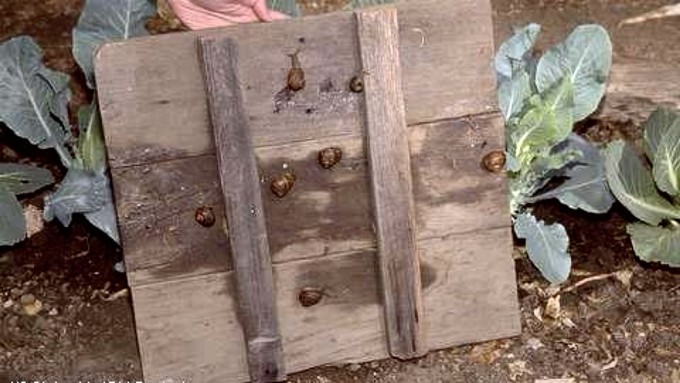
These slimy pests are particularly active after rain

Snails collect on the underside of a wooden board that had been placed in a vegetable garden. This homemade trap should be checked daily. Courtesy UC IPM, photo by Jack Kelly Clark
They’re the slime of garden pests. Under the cover of darkness, they munch away on young lettuce, cabbage and other cool-season vegetables, destroying young transplants and frustrating gardeners to no end. And with recent rain, these land-loving mollusks have become particularly active – and voracious.
“Snails and slugs rank among our most despised garden pests,” say the UC Cooperative Extension master gardeners. Not only do they attack foliage, but also flowers and fruit.
Although their silvery slime trails are a telltale sign of their activity, those tracks don’t necessarily lead to these little culprits. They can hide under other plants or beneath pots or buried among fallen leaves.
According to the master gardeners, the only way to effectively control snails and slugs is vigilance – plus some home-made traps.
“Management requires a vigilant and integrated approach that includes eliminating moisture and hiding spots, trapping, barriers and hand-picking,” say the master gardeners. “Baits can be helpful, but by themselves don’t provide adequate control in gardens that contain plenty of shelter, food and moisture.”
The master gardeners suggest visiting your garden at night with a flashlight to catch the snails and slugs in the act, then picking them off by hand for disposal. Look around the edges of raised beds and under neighboring shrubs or perennials; that’s where they like to hide before their nocturnal foraging.
Creating a “hiding place” is among the best ways to trap these slippery pests. Take a board (12 by 15 inches is ideal, say the master gardener) and place it in the garden, atop 1- by 1-inch runners with some gaps around the edges. (You can use wooden stakes laid flat on the ground for this purpose.) That inch of space invites snails and slugs to crawl under the board and congregate.
In the morning, check under the board – and dispose of those snails and slugs. To be truly effective, the board needs to be checked regularly, preferably daily.
Watering in the morning instead of later in the day or evening can help reduce the excess moisture these animals need to move around. So does drip irrigation.
Location also goes a long way in cutting down on snail or slug damage. “Place your garden in the sunniest spot possible,” advise the master gardeners. “Remove garden objects, adjacent plants or ground cover that can serve as shady shelter.”
A 4-inch-wide strip of copper sheeting also can be a good barrier to snails and slugs; they can’t crawl over copper. Bury the strip 1 inch deep or attach it to the top edge of a raised bed, and slightly bend the top edge away from the plants you want to protect. But the copper barrier only works if the patch you’re protecting is already snail- and slug-free.
Avoid metaldehyde baits; they’re especially poisonous to dogs and birds. In addition, they quickly lose their effectiveness due to sunlight and moisture from rain or irrigation.
Iron phosphate baits are safe for use around pets, people and wildlife. They can come in handy around sprinklers or other moist areas where slugs and snails tend to hang out. Irrigate BEFORE scattering iron phosphate bait. Apply it in the evening after a warm day; that’s when snails and slugs are most active.
Another solution: Plant what snails and slugs won’t eat. “Consider snail-proof plants such as impatiens, geraniums, begonias, lantana, nasturtiums and many plants with stiff leaves and highly scented foliage like sage, rosemary and lavender,” say the master gardeners.
For more on managing snails and slugs: https://ipm.ucanr.edu/PMG/PESTNOTES/pn7427.html.
Comments
0 comments have been posted.Sacramento Digs Gardening to your inbox.
Sites We Like
Garden Checklist for week of July 21
Your garden needs you!
* Keep your vegetable garden watered, mulched and weeded. Water before 8 a.m. to reduce the chance of fungal infection and to conserve moisture.
* Feed vegetable plants bone meal, rock phosphate or other fertilizers high in phosphate to stimulate more blooms and fruiting. (But wait until daily high temperatures drop out of the 100s.)
* Don’t let tomatoes wilt or dry out completely. Give tomatoes a deep watering two to three times a week.
* Harvest vegetables promptly to encourage plants to produce more. Squash especially tends to grow rapidly in hot weather. Keep an eye on zucchini.
* Pinch back chrysanthemums for bushy plants and more flowers in September.
* Remove spent flowers from roses, daylilies and other bloomers as they finish flowering.
* Pinch off blooms from basil so the plant will grow more leaves.
* Cut back lavender after flowering to promote a second bloom.
* It's not too late to add a splash of color. Plant petunias, snapdragons, zinnias and marigolds.
* From seed, plant corn, pumpkins, radishes, winter squash and sunflowers.